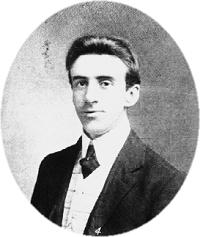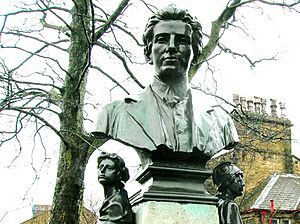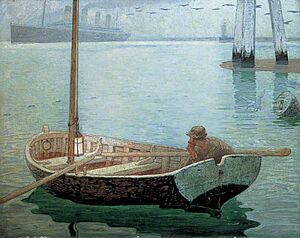Wallace Hartley facts for kids
Quick facts for kids
Wallace Hartley
|
|
|---|---|

Portrait of Hartley published in The Illustrated London News, May 1912
|
|
| Born |
Wallace Henry Hartley
2 June 1878 Colne, Lancashire, England
|
| Died | 15 April 1912 (aged 33) North Atlantic Ocean
|
| Cause of death | Sinking of the Titanic |
| Occupation |
|
Wallace Henry Hartley (born June 2, 1878 – died April 15, 1912) was an English violinist. He led the band on the famous ship, the Titanic. The band played music as the ship sank on April 15, 1912. Hartley and all the other band members died. They became famous for their bravery.
Contents
Early Life and Musical Journey
Wallace Hartley was born and grew up in Colne, England. His father, Albion Hartley, was a choirmaster at their church. He taught the hymn "Nearer, My God, to Thee" to the church members.
Wallace went to a Methodist school in Colne. He sang in the church choir. He also learned to play the violin from someone in his church.
After school, Hartley worked at a bank. Later, his family moved to Huddersfield. There, Wallace joined the Huddersfield Philharmonic Orchestra. In 1903, he left home. He joined the town orchestra in Bridlington. He stayed there for six years.
He then moved to Dewsbury, West Yorkshire. In 1909, he started working for the Cunard Line. He was a musician on large ships. These ships included the RMS Lucania, RMS Lusitania, and RMS Mauretania.
While on the Mauretania, Hartley's job changed. Musicians were now hired by a music agency. This meant he was seen as a passenger, not a crew member. The agency paid for his second-class cabin. Sadly, neither the shipping company nor the agency insured the musicians.
In April 1912, Hartley got a new job. He was chosen to lead the band on the White Star Line's new ship, the RMS Titanic. He had just asked his girlfriend, Maria Robinson, to marry him. He did not want to leave her. But he thought working on the Titanic's first trip would help his career.
The Sinking of the Titanic
On the night of April 14, 1912, the Titanic hit an iceberg. The ship began to sink. Hartley and his band started playing music. They wanted to help keep the passengers calm. This happened while the crew loaded the lifeboats.
Many people who survived said the band kept playing. They played music until the very end. None of the band members lived through the sinking. Their story of playing until the end became a famous legend. A newspaper at the time wrote about their "noblest" act of heroism.
No one knows for sure what the last song the band played was. But "Nearer, My God, to Thee" is the most popular guess. A book called A Night to Remember (1955) made this idea famous. It shared a wireless officer's story. He said he heard the song "Autumn."
However, a musician who worked with Hartley said something else. Hartley had told him he would play "Nearer, My God, to Thee" or "Our God, Our Help in Ages Past" if his ship ever sank. If "Nearer, My God, to Thee" was played, it is likely the version his father used. This version was by Arthur Sullivan. The first notes of this tune are on Hartley's memorial. They were also played at his funeral.
After the Sinking

Wallace Hartley's body was found almost two weeks after the sinking. It was found by a ship called the Mackay–Bennett. News reports said he was found "fully dressed with his music case strapped to his body."
His body was taken to the Arabic. Then it was brought back to England. Hartley's father met the ship in Liverpool. He brought his son's body home to Colne. The funeral was held on May 18, 1912. About one thousand people attended the funeral. An estimated 30,000 to 40,000 people lined the streets for his funeral procession.
Hartley is buried in the Keighley Road cemetery in Colne. A 10-foot tall headstone marks his grave. It has a carved violin at its base.
A memorial to Hartley was put up in 1915. It has a bust of him on top. It stands outside what was then the town library. The memorial says:
Bandmaster of the RMS Titanic who perished in the foundering of that vessel, April 15th 1912. Erected by voluntary contributions to commemorate the heroism of a native of this town.
This memorial was later moved a little. This was to make room for a World War One memorial. Hartley's old house in Dewsbury, West Yorkshire, has a blue plaque. It reminds people that the bandleader lived there.
Another memorial for all the Titanic musicians was built. It is in Broken Hill, Australia. People there were so touched by the band's bravery. They quickly raised money for a memorial. It looks like a broken pillar. It was shown to the public in December 1913.
The City of Ballarat, Australia, also has a bandstand. It honors the lost musicians. It was built by the Ballarat Council. Money was raised by a band association and citizens. The Titanic Memorial bandstand was shown on October 22, 1915. Every year, on the anniversary of the sinking, a band still plays "Nearer, My God, To Thee" there.
In 2001, new streets and houses in Colne were named after Hartley. In 2008, a pub in Colne was named "The Wallace Hartley."
A painting from 1912 is called The Outward Bound. It was painted by Frederick Cayley Robinson. It shows a young person watching the Titanic leave Southampton. This painting was made to remember Hartley. It was given to Leeds Art Gallery.
Hartley's Violin
In March 2013, a special discovery was made. A violin was found in a British man's attic. It was in a leather case with the letters "W. H. H." on it. After many tests, experts said it was the violin Hartley used on the Titanic.
The violin had a special message on it. Hartley's girlfriend, Maria Robinson, had put it there in 1910. It said: 'For Wallace on the occasion of our engagement from Maria.' Experts also checked a silver plate on the violin. They confirmed it was real and from that time. A CT scan helped experts see inside the violin. This showed how it was made and if it had been fixed.
While researching the violin, a diary was found. It belonged to Maria Robinson. In it, she wrote about a telegram from July 19, 1912. In the telegram, she thanked people for returning her fiancé's violin.
After Maria Robinson died in 1939, her sister gave the violin away. She gave it to the Bridlington Salvation Army. She told them about its connection to the Titanic. The violin was later given to a violin teacher. This teacher then gave it to the family who owned it for over 70 years. A Titanic expert named Craig Sopin believes the violin is real. He said it is "Hartley's violin and not a fraud."
The Hartley violin was shown in Northern Ireland. It was at the shipyard where the Titanic was built, Titanic Belfast. It was also shown in museums in the United States. On October 19, 2013, the violin was sold at an auction. It sold for £900,000 (about $1.7 million US).
The violin is now at the Titanic Belfast Museum. People can go and see it. It has two big cracks and cannot be played anymore.
The story of Wallace Hartley and his violin has inspired music. British singer Reg Meuross wrote a song called "The Band Played Sweet Marie." Canadian singer Heather Rankin also wrote a song called "Titanically." A music video for "Titanically" was released on June 2, 2017. This was to honor Hartley's birthday.
Wallace Hartley in Movies
Wallace Hartley has been shown in several movies and TV shows:
- Charles Belchier played him in A Night to Remember (1958 film).
- Victor Langley played him in S.O.S. Titanic (1979 TV movie).
- Jonathan Evans-Jones played him in Titanic (1997 film).
- Csongor Veer played him in Titanic (2012 TV miniseries).
Images for kids
See also
 In Spanish: Wallace Hartley para niños
In Spanish: Wallace Hartley para niños



